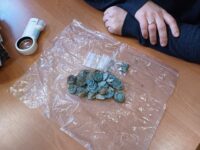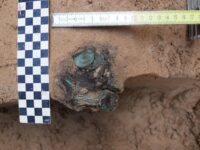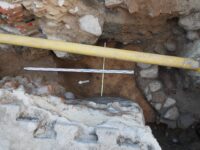 A hoard of medieval Silesian bracteate coins has been discovered in the city center of Szprotawa, western Poland. There are about 100-150 coins minted between 1250 and 1300 in the hoard. Some of the coins were found in cylindrical stacks, indicating they were carefully arranged before being placed in a textile bag with some loose coins. The bag was then tightly tied to keep the coin stacks in place before being buried at a shallow depth on one of the main streets connecting the market square to the Głogowska Gate in the city’s 13th century defensive walls.
A hoard of medieval Silesian bracteate coins has been discovered in the city center of Szprotawa, western Poland. There are about 100-150 coins minted between 1250 and 1300 in the hoard. Some of the coins were found in cylindrical stacks, indicating they were carefully arranged before being placed in a textile bag with some loose coins. The bag was then tightly tied to keep the coin stacks in place before being buried at a shallow depth on one of the main streets connecting the market square to the Głogowska Gate in the city’s 13th century defensive walls.
Silesian bracteates were minted on one side of a thin silver plate leaving an impression on the obverse that appears on the reverse as a negative. The silver had a high copper content, which is why the surface of the coins now has a green patina. The bracteates were of comparatively low value because of their low precious metal content and susceptibility to wear and tear. Rulers often recalled the coins and replaced them with new ones to refresh the value of the rapidly depreciating coins.
 The historic center of Szprotawa is undergoing a comprehensive revitalization program that includes the reconstruction of all the communications infrastructure, new bicycle paths leading to a bicycle station, the renovation town hall, the secondary school, police headquarters and two historic churches. The work is being carried out under the supervision of archaeologists as the medieval city was all but levelled in World War II — an estimated 90% of Szprotawa was destroyed — making the archaeological material underground all the more significant.
The historic center of Szprotawa is undergoing a comprehensive revitalization program that includes the reconstruction of all the communications infrastructure, new bicycle paths leading to a bicycle station, the renovation town hall, the secondary school, police headquarters and two historic churches. The work is being carried out under the supervision of archaeologists as the medieval city was all but levelled in World War II — an estimated 90% of Szprotawa was destroyed — making the archaeological material underground all the more significant.
 Most of the finds so far have been the remains of 19th century tenement house cellars built after the demolition of the medieval walls, but earlier remains have also been uncovered, notably fragments from a 15th century bridge, pieces of the city wall from the early 14th century, the remains of a tower and a section of the medieval Głogów Gate.
Most of the finds so far have been the remains of 19th century tenement house cellars built after the demolition of the medieval walls, but earlier remains have also been uncovered, notably fragments from a 15th century bridge, pieces of the city wall from the early 14th century, the remains of a tower and a section of the medieval Głogów Gate.
The coins are of particular significance because of their dates. First recorded in around 1000 A.D. as a small settlement, Szprotawa was grated town rights in 1260 and full city rights in 1304. Its defensive walls were built by Silesian Piast Duke Konrad I of Głogów after he granted Szprotawa its town rights, so the coins were minted as the city came into its own.
* This article was originally published here











No comments:
Post a Comment